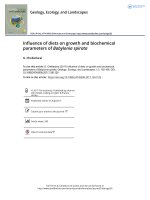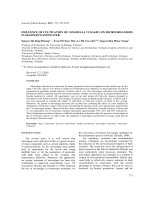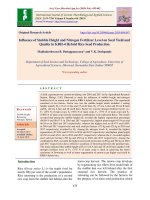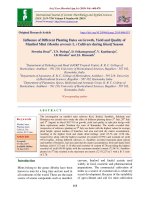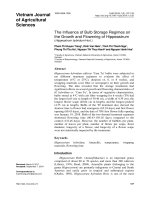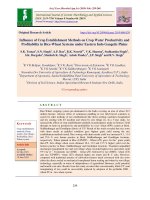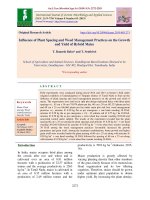Influence of weather parameters on the incidence of serpentine leaf miner, Liriomyza trifolii (Burgess) on tomato
Bạn đang xem bản rút gọn của tài liệu. Xem và tải ngay bản đầy đủ của tài liệu tại đây (334.62 KB, 6 trang )
Int.J.Curr.Microbiol.App.Sci (2020) 9(5): 2260-2265
International Journal of Current Microbiology and Applied Sciences
ISSN: 2319-7706 Volume 9 Number 5 (2020)
Journal homepage:
Original Research Article
/>
Influence of Weather Parameters on the Incidence of
Serpentine leaf miner, Liriomyza trifolii (Burgess) on Tomato
Naga Sri Navya Ravipati1*, Abhishek Shukla2 and Bhojeswari Sahu2
1
2
Department of Agricultural Entomology, CPPS, TNAU, Coimbatore – 641003, India
Jawaharlal Nehru Krishi Vishwa Vidyalaya, Jabalpur, Madhya Pradesh – 482004, India
*Corresponding author
ABSTRACT
Keywords
Correlation,
Population
dynamics,
Regression,
Tomato,
Weather factors
Article Info
Accepted:
18 April 2020
Available Online:
10 May 2020
The present investigation was carried out to study the seasonal abundance
of Serpentine leaf miner, Liriomyza trifolii on tomato during 2017-18. Leaf
miner reached peak during December to January and declined thereafter.
Correlation studies revealed that, no. of mines, leaf infestation and no. of
larvae were negatively correlated with minimum temperature (-0.61**),
evening relative humidity (-0.34*), morning vapor pressure -0.55*, evening
vapor pressure -0.52*, maximum temperature-0.57*, sunshine hours -0.52*
and evaporation -0.58**, temperature and evening relative humidity.
Whereas, leaf infestation per cent is positively correlated with evaporation
(0.71**) and influenced the leaf miner population by 51 per cent.
Introduction
Vegetables occupy a prominent position in
human diet owing to their richness in vitamins
and minerals. More than seventy types of
vegetables are grown in India, among which
Tomato (Lycopersicon esculentum Mill) is the
most popular and widely grown vegetable. It
is rich source of vitamin ‛C’ and many
minerals like calcium, potassium, magnesium
and phosphorus (Anonymous, 2006). It is the
world's largest vegetable crop after potato and
sweet potato. Tomato is also called as poor
man’s apple (Roopa, 2012). In India, an
approximate vegetable production of 168.6
million tonnes was recorded from an area of
10.29 million ha, out of which tomato
production was 19.7 million tonnes in an area
of 0.8 million ha with average productivity
24.6 tonnes/ha (Anonymous, 2017). Madhya
Pradesh is endowed with favourable climatic
and soil conditions for cultivation of tomato,
with 3.1 million tonnes production and 31.2
metric tonnes productivity in an area of 0.1
million ha (Anonymous, 2017). Various
factors are responsible for crop yield, among
2260
Int.J.Curr.Microbiol.App.Sci (2020) 9(5): 2260-2265
which American serpentine leaf miner,
Liriomyza trifolii (Burgess) (Agromyzidae;
Diptera) is the serious pest of tomato crop. It
is suspected to have been introduced in India
during
1990-91
through
imported
chrysanthemum cutting (Viraktamath et al.,
1993). It is a polyphagous pest. In India it was
recorded on 70 host plants covering fibre
crops, pulses, vegetables, ornamentals, green
manures, fodder crops etc. (Srinivasan et al.,
1995). Galande et al., (2004) recorded this
pest on 16 new crops and 16 weed species.
The estimated yield losses due to infestation
by L. trifolii were about 70 per cent (Zoebisch
et al., 1984). Therefore, it is essential to
understand their population dynamics under
field condition so that, timely management
practices can be done. A thorough knowledge
on seasonal activity of pests determines the
predisposing climatic factors affecting their
population dynamics. Keeping in view the
importance of the crop and losses caused by
different insect pests, the present study was
made to assess the population dynamics of
pests on tomato.
Materials and Methods
The study on effect of weather parameters on
incidence of leaf miner, L.trifolii was
conducted at Breeder seed production unit
Jawaharlal Nehru Krishi Vishwa Vidyalaya,
Jabalpur during Rabi season of the year 201718.Tomato seedlings were transplanted during
third week of October in a plot size of 3X4 m
with a spacing of 50X60 cm. The crop was
raised by following all the recommended
agronomical practices. Observations like leaf
infestation (%), no. of mines/leaf and mean
larval population/plant were recorded by
tagging fifty plants at random. Total number
of leaves, damaged or infested leaves of each
plant and the number of larvae present in the
mines were counted. Observations were
recorded at weekly intervals starting from
transplanting to the crop harvest. The whole
experiment field was kept free without any
insecticide application. To find out the
specific impact of different weather
parameters on L. trifolii, data was analyzed
using OPSTAT statistical software.
Results and Discussion
The
seasonal
incidence,
correlation
coefficients and multiple regressions were
estimated on leaf miner infestation with
maximum
temperature,
minimum
temperature, morning relative humidity,
evening relative humidity, sunshine hours,
morning vapor pressure, evening vapor
pressure and evaporation of appropriate
weeks during 2017 and 2018. It is evident
from the data that, the incidence of leaf miner
was first noticed during 44th standard week
(October) and reached to peak during 1st week
(January). Leaf miner found a decline from
2nd week (January) onwards. Correlation
analysis between no. of mines/leaf and
weather factors revealed that, negative
association was observed with minimum
temperature, evening relative humidity,
morning vapor pressure, evening vapor
pressure and evaporation which favour the
incidence of leaf miner (Table 1).
Multiple regression analysis showed that,
minimum temperature, evening relative
humidity, morning vapor pressure, evening
vapor pressure and evaporation influenced the
leaf miner population by 38 (R2= 0.3785), 12
(R2 = 0.1244), 30 (R2 = 0.3012), 28 (R2 = 0.
2875) and 34 (R2 = 3432) per cent
respectively and a unit decrease in them
increased the leaf miner population by 0.05,
0.01, 0.07, 0.07 and 0.29 in number (Table 2).
Regarding leaf infestation per cent correlation
studies revealed that morning vapor pressure,
evening vapor pressure and evaporation has
negative correlation. From regression
analysis, it is revealed that, morning vapor
pressure, evening vapor pressure and
2261
Int.J.Curr.Microbiol.App.Sci (2020) 9(5): 2260-2265
evaporation influenced the leaf miner
population by 78 (R2 = 0.7844), 39 (R2 =
0.3899) and 51 (R2 = 0.5112 per cent and a
unit decrease in them increased the leaf miner
population by 2.89, 2.32 and 9.03 in number
(Table 2). Correlation data showed that
maximum temperature, sunshine hours,
morning vapor pressure, evening vapor
pressure and evaporation has negative
influence on no. of larvae/plant (Fig. 1).
Table.1 Leaf miner activity on tomato
Months
October
November
November
November
November
December
December
December
December
January
January
January
January
February
February
February
February
Standard Week
numbers
44
45
46
47
48
49
50
51
52
1
2
3
4
5
6
7
8
No. of
mines/leaf
3.41
3.26
3.32
3.59
4.63
4.87
5.51
4.14
6.23
6.35
3.89
3.75
3.32
3.06
2.85
2.72
2.58
Leaf
infestation %
15.00
21.00
26.80
31.00
34.00
36.30
41.50
43.40
47.33
51.25
50.12
49.16
42.70
35.00
28.40
25.30
23.60
No. of
larvae/plant
3.24
5.55
10.32
13.98
15.93
22.34
20.41
26.96
32.36
38.33
32.68
28.84
26.44
21.26
17.62
15.28
12.24
Table.2 Estimated correlation coefficients (r), regression coefficients (bxy) and R square values
of weather factors on incidence of leaf miner
Weather factors
Maximum temperature
Minimum temperature
Sunshine hours
Morning relative humidity
Evening relative humidity
Morning vapor pressure
Evening vapor pressure
Evaporation
No. of
mines/leaf
R
R2
-0.27NS 0.07
-0.61** 0.38
0.42NS 0.08
0.13NS 0.06
-0.34* 0.12
-0.55* 0.30
-0.52* 0.28
-0.58** 0.34
bxy
-0.05
-0.01
-0.07
-0.07
-0.29
Leaf infestation
%
r
R2
-0.45NS 0.20
-0.35NS 0.12
0.40NS
0.16
0.21NS
0.04
-0.23NS 0.05
-0.86**
0.78
-0.62**
0.39
0.71**
0.51
NS -Non significant, * - Significant at 5% level, ** - Significant at 1% level
2262
bxy
-0.21
-2.89
-2.32
-9.03
No. of
larvae/plant
r
R2
-0.57*
0.26
-0.32NS 0.10
-0.52*
0.26
0.12NS 0.06
-0.11NS 0.01
-0.89** 0.79
-0.58** 0.33
-0.70** 0.49
bxy
-0.28
-0.25
-0.51
-0.37
-1.54
Int.J.Curr.Microbiol.App.Sci (2020) 9(5): 2260-2265
Fig.1
Max temp, min temp, sunchine, mng
(rh), evng (rh), Mng (vp), evng
(vp), Evapo (mm)
No. of mines/leaf
Leaf infestation %
60.00
No. of larvae/plant
50.00
40.00
30.00
20.00
10.00
0.00
0
5
10
15
20
Metorological week number
Whereas, regression studies revealed that,
maximum temperature, sunshine hours,
morning vapor pressure, evening vapor
pressure and evaporation influenced the leaf
miner population by 26 (R2 = 0.2612), 26 (R2
= 0.2641), 79 (R2 = 0.7932), 33 (R2 = 0.3315)
and 49 (R2 = 0.4941) per cent, and a unit
decrease in them increased the leaf miner
population by 0.28, 0.25, 0.51, 0.37 and 1.54
in number (Table 2).
The occurrence and progress of all insect
pests are much dependent on the
environmental factors such as temperature,
relative humidity and precipitation (Aheer et
al., 1994). In order to precisely assess the
relative importance of weather parameters in
explaining the variation in population of pest,
the partial regression coefficients of leaf
miner on weather parameters were computed
taking population of pests as dependent
variables and maximum and minimum
temperatures, relative humidity, vapor
pressure, rainfall and evaporation as
independent variables. The present findings
are in accordance with Choudary and Rosaiah
(2000) reported that minimum temperature
and evening relative humidity were negatively
correlated with L. trifolii incidence in tomato.
Reddy and Kumar (2005) reported that mean
and total rainfall as well as number of rainy
days significantly negatively correlated with
seasonal abundance of leaf miner while,
negative non-significant correlation obtained
between morning and evening relative
humidity. Galande and Ghorpade (2010)
showed negative correlation between morning
relative humidity and L. trifolii incidence.
Chakraborty (2011) also reported that
temperature and maximum as well as
minimum relative humidity had significant
negative influence on L. trifolii population.
Variya and Patel (2010) reported that
maximum temperature and sunshine had
negative influence on larval populations of
leaf miner.
From the data it is clear that temperature, is
an important unique meteorological that
influences the pest population. This study
gives us the impact of extreme climatic
conditions. Similarly, relative humidity, vapor
pressure and evaporation has their influence
in the build-up of L. trifolii. Knowing the
2263
Int.J.Curr.Microbiol.App.Sci (2020) 9(5): 2260-2265
behaviour of this pest under variable climatic
factors, this study may be helpful in rescheduling
the
pesticide
uses
and
modification of some available control
options in infestation of this pest in tomato.
Those planters who make the best use of the
basics of integrated pest management such as
field monitoring, pest forecasting and
choosing economically and environmentally
sound control measures will be successful in
dealing the effects of climatic factors.
References
Anonymous. 1995. Observation trial on
Liriomyza trifolii on tomato. A report of
research work done on vegetable
entomology during 1994-95. Dr.Panjab
Rao Deshmukh Krishi Vidyapeeth.
Anonymous. 2006 (a). Economic survey of
India 2005-06. India.
Anonymous. 2016-17. Annual report of
National Horticulture Board, Haryana.
Aheer, G. M., K. J. Ahmed and Ali, A. 1994.
Role of weather influctuating aphid
density in wheat crop. Journal of
Agricultural Research.32:295-301.
Asalatha, R. 2002. Seasonal activity and bioefficacy
of
some
eco-friendly
insecticides against the serpentine leaf
miner Liriomyza trifolii. Master’s thesis,
Jawaharlal Nehru Krishi Vishwa
Vidyalaya, Jabalpur, India.
Bhupender, S., and Narender, H. 2017.
Seasonal incidence and management of
sorghum shoot fly, Atherigonasoccata
(Rondani) - A Review. Forage
Research. 42(4):218-224.
Chakraborty, K. 2011. Incidence and
abundance of tomato leaf miner,
Liriomyza trifolii (Burgess) in relation
to the climatic conditions of Alipurduar,
Jalpaigur, West Bengal, India. Asian
Journal of Experimental Biological
Sciences. 2(3):467-473.
Choudary, D.P., and Rosaiah, R. B. 2000.
Seasonal occurrence of Liriomyza
trifolii (Burgess) (Agromyzidae:Diptera)
on tomato crop and its relation with
weather parameters. Pest Management
Eco Zoology. 8(1):91-95.
Durairaj. 2007. Influence of abiotic factors on
the incidence of serpentine leaf miner,
Liriomyza trifolii. Indian journal of plant
protection. 35(2):232-234.
Devinder, S., M. Asifa, A. Hafeez,
andVishav,
V.
S.
J.
2012.
Meteorological factors influencing
insect pests of Tomato. Annals of Plant
Protection Sciences. 21(1):68-71.
Frick, K.E.1957. Nearctic species in the
Liriomyza, pusilla complex, No.2, L.
munda and two other species attacking
crops
in
California
(Diptera:
Agromyzidae).
Pan-Pacific
Entomologist 33(2):59-70.
Galande, S.M., U.N. Mote, and Ghorpade, S.
A. 2004. New host plants of serpentine
leaf miner, Liriomyza trifolii in western
Maharashtra. Annals of Plant Protection
Sciences. 12:425-475.
Galande, S.M., and Ghorpade, S. A. 2010.
Population dynamics of serpentine leaf
miner (Liriomyza trifolii Burgess) on
tomato
and
its
relation
with
meteorological parameters. Journal of
Maharashtra Agricultural Universities.
35(1): 89-92.
Hemalatha, B., and Maheswari, T. U. 2004.
Biology and seasonal incidence of
serpentine leaf miner, Liriomyza trifolii
(Burgess) on tomato in southern zone of
Andhra Pradesh. Indian Journal of
Entomology. 66(2):107-110.
Jian, L., R.S. Dakshina, L.L. Gary and Oscar,
E. L. 2012. Seasonal abundance and
spatial distribution of the leafminer,
Liriomyza
trifolii
(Diptera:
Agromyzidae), and its Parasitoid,
Opiusdissitus
(Hymenoptera:
Braconidae), on bean in Southern
Florida. Florida Entomological Society.
2264
Int.J.Curr.Microbiol.App.Sci (2020) 9(5): 2260-2265
95(1):128-135.
Johnson, M.W., C. Welter, N.C. Toscano, I.P.
Ting, Trumble, J. T. 1983. Reduction of
tomato leaflet photosynthesis rates by
mining activity of Liriomyza sativae
(Diptera: Agromyzidae). Journal of
Economic Entomology. 76:1061-1063.
Lakshminarayana, M., H. Basappa and Singh,
V. 1992. Report on the incidence of
hitherto unknown leaf miner Liriomyza
trifolii
158
(Burgess)
(Diptera:
Agromyzidae) on castor. Journal of
Oilseeds Research. 9(1):175-176.
Levins, R.A., S.L. Poe, R.C. Littell, Jones, J.
P. 1975. Effectiveness of a leaf miner
control program for Florida tomato
production. Journal of Economic
Entomology. 68:772-774.
Roopa, S. P. 2012. Epidemiology and
management of early blight of tomato
caused by Alternaria solani (Ellis and
Martin) Jones and Grout, M.Sc. Thesis,
University of Agricultural Sciences,
Dharwad, India.
Reddy, N.A., and Kumar, C. T. A. 2005.
Influence of weather factors on
abundance
and
management
of
Serpentine leaf miner, Liriomyza trifolii
(Bugress) on tomato. Annals of Plant
Protection Sciences. 13:315-318.
Saradhi, P., and Patnaik, N. C. 2004. Seasonal
population fluctuations of serpentine
leaf miner, Liriomyza trifolii (Burgess)
in different host plants. Journal of
Applied
Zoological
Researches.
15(1):60-63.
Srinivasan, K., C. A. Viraktamath, M. Gupta
and Tiwari, G. C. 1995. Geographical
distribution host range and parasitoid of
serpentine leaf miner, Liriomyza trifolii
(Burgess) in south India. Pest
Management
in
Horticultural
Ecosystem. 1: 93-100.
Selvaraj, S., R.S. Bishit and Ganeshamoorthi,
P. 2016. Seasonal incidence of
American serpentine
leaf miner
Liriomyza trifolii (Bugress) on Tomato.
International Journal of Agriculture
Sciences. 8(38):1777-1779.
Sharma, D., and Sharma, S. 1997. Status of
Liriomyza trifolii(Burgess) and its host
plants in Jabalpur district in Madhya
Pradesh. Cropresearch (Hisar). 14(2):
351-355.
Variya, M.V., and Patel, J. J. 2013.
Population dynamics of Leaf miner
(Liriomyza trifoliiBugress) on tomato in
relation to weather parameters. An
international e-Journal 2(3): 385-391.
Viraktamath, C. A., G. C. Tewari, K.
Srinivasan and Gupta, M. 1993.
American Serpentine leaf miner is a new
threat to crops. Indian Farming. pp 1012.
Zoebisch, T.C., D. J. Schuster and Gilreath,
J.P. 1984. Liriomyza trifolii: Oviposition
and development in foliage of tomato
and common weed hosts. Florida
Entomologist. 67(2): 250-254.
How to cite this article:
Naga Sri Navya Ravipati, Abhishek Shukla and Bhojeswari Sahu. 2020. Influence of Weather
Parameters on the Incidence of Serpentine leaf miner, Liriomyza trifolii (Burgess) on Tomato.
Int.J.Curr.Microbiol.App.Sci. 9(05): 2260-2265. doi: />
2265

